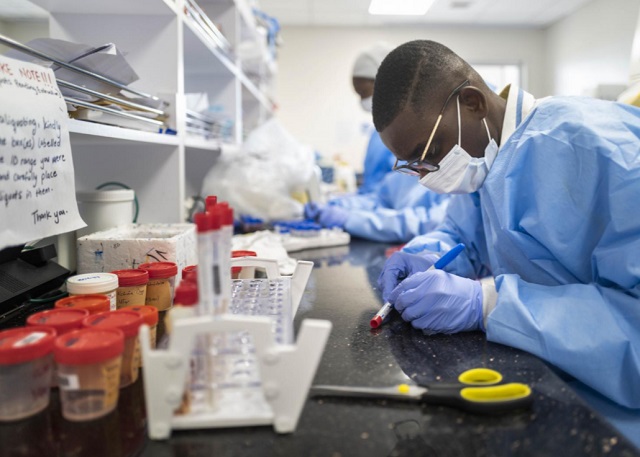
How cheaper pooled testing increase access in Ghana, Rwanda
| THE INDEPENDENT | The COVID-19 pandemic tends to conceal other important health issues. One of these is the global target for reducing HIV infections and increasing access to treatment. Progress is well under way. In 2019, 67% of those living with HIV were receiving antiretroviral therapy (ART), and 85% of pregnant women with HIV were receiving medication to prevent transmission to their babies.
But these interventions depend on diagnostic laboratory testing for their success.
Regular determination of the HIV viral load is necessary to monitor patients receiving ART. This means measuring the concentration of HIV nucleic acid (viral genome) in the patient’s blood. In optimally treated patients, the viral load becomes and remains undetectable. When a patient has a suppressed viral load it means that their treatment is working and they are non-infectious. This is one of the benefits of universal ART. Theoretically, HIV can be eradicated if everyone who is infected becomes non-infectious due to treatment.
Infants who are exposed to HIV need the earliest possible diagnosis. The sooner ART is started, the better the clinical outcome. Called early infant diagnosis of HIV, this requires qualitative testing for the virus itself by detecting HIV genomes. This is because infants born to mothers with HIV infection have maternal antibodies for a year or longer, making antibody tests useless.
Both quantitative and qualitative HIV genome tests require sophisticated instruments. Except where relatively expensive near-patient systems are available, HIV genome tests are mostly done on massive, largely automated high-throughput platforms in specialised laboratory facilities by highly qualified staff. This makes these tests expensive and therefore many people on the continent still struggle to access such testing.
Simple and cost‐effective viral load tests that facilitate simplification and decentralization of testing and strategies, such as the use of dried blood spots and pooled sample testing, which further aid simplification, are becoming available. In addition, replacing immunological monitoring with virological monitoring in non‐viremic patients in a phased manner will reduce the costs associated with dual immuno‐virological monitoring. Going forward, the simplification of testing paired with price reducing strategies that will allow for healthy competition between multiple manufacturers will enable the implementation of viral load testing in resource‐poor settings.
But there is good news. Though numbers of patients needing viral load and early infant diagnosis testing are increasing and will remain high, infant HIV infections and ART failures are becoming rarer because the interventions are so successful. This is opening opportunities for pooled testing.
Pooled testing, also known as pooling or group testing, has been used for decades to efficiently diagnose relatively rare conditions, such as infection in blood donors. In a recent paper, we highlight its potential role for universal early infant HIV diagnosis and viral load coverage.
Pooled testing
Pooled testing means performing a laboratory test on several different samples mixed together. If the test result for the pool is negative, all individual samples contained in this pool can get a negative result straightaway. So together they would have used just one test. But if a pool tests positive, the samples it contains need to be re-tested individually (“de-convolution” or “resolution”).
Ghana and Rwanda are currently using pool testing.
Noguchi Memorial Institute for Medical Research, Ghana’s first facility able to test for COVID-19, has deployed “pooled sampling” to meet demand. Each pool has 10 samples and 100 pools are tested at a time. Instead of testing one person at a time, samples from multiple individuals are put together and tested as one pool.
Pooled sampling has not only rapidly scaled up PCR testing capacity, but ultimately uses less testing reagents, and has shortened the results waiting time to two from around six days, helping to shift the backlog of samples for testing that have built up in the laboratories, and relieving overcrowded isolation centres.
This method of COVID-19 testing can not only be cost-effective, it can also be used at points of entry, in areas with low prevalence of the virus as well as to test asymptomatic people, notes Dr Yahaya Ali Ahmed, a laboratory expert at WHO Regional Office for Africa.
However, he points out that in areas with high COVID-19 transmission, pooled testing can give more positive results and reduce testing sensitivity due to dilution as specimens are grouped.
In July, the U.S. Food and Drug Administration reissued an emergency use authorization (EUA) to Quest Diagnostics to authorise its Quest SARS-CoV-2 rRT-PCR test for use with pooled samples containing up to four individual swab specimens collected under observation. The Quest test is the first COVID-19 diagnostic test to be authorised for use with pooled samples.
Sample pooling is an important public health tool because it allows for more people to be tested quickly using fewer testing resources.
Sample pooling does this by allowing multiple people – in this case four individuals – to be tested at once. The samples collected from these four individuals are then tested in a pool or “batch” using one test, rather than running each individual sample on its own test.
If the pool is positive, it means that one or more of the individuals tested in that pool may be infected, so each of the samples in that pool are tested again individually. Because the samples are pooled, it is expected that fewer tests are run overall, meaning fewer testing supplies are used and more tests can be run at the same time allowing patients to receive their results more quickly in most cases. This testing strategy is most efficient in areas with low prevalence, meaning most results are expected to be negative.
 The Independent Uganda: You get the Truth we Pay the Price
The Independent Uganda: You get the Truth we Pay the Price



